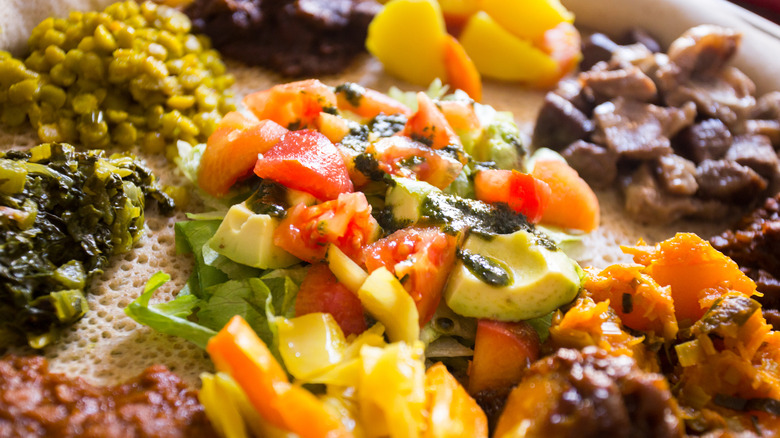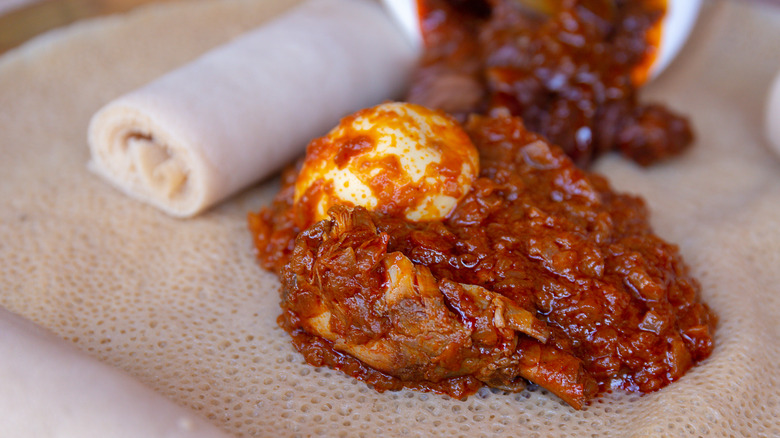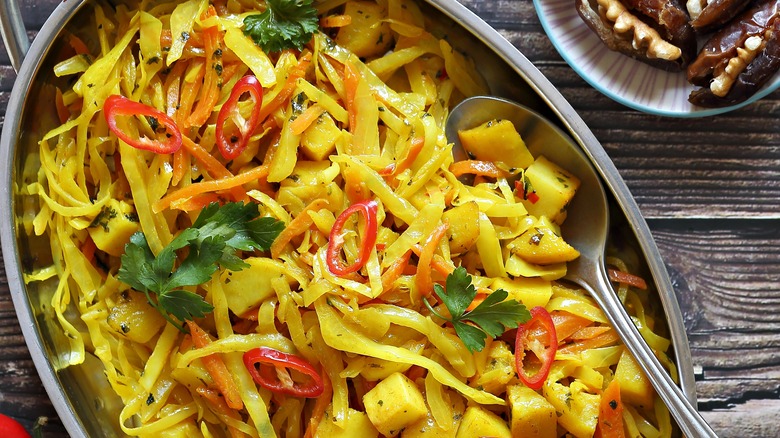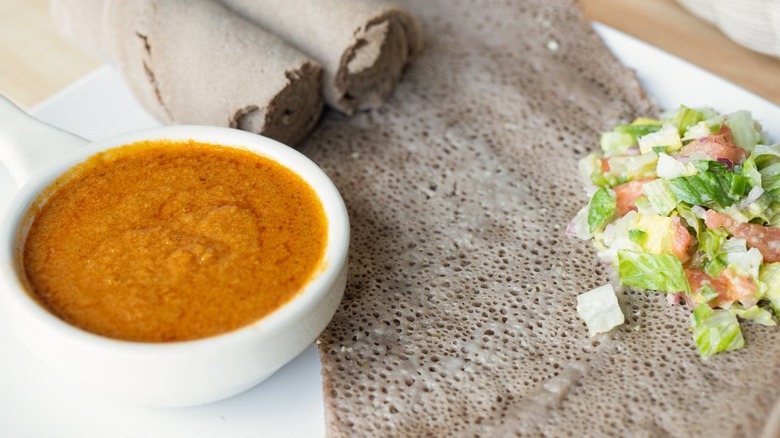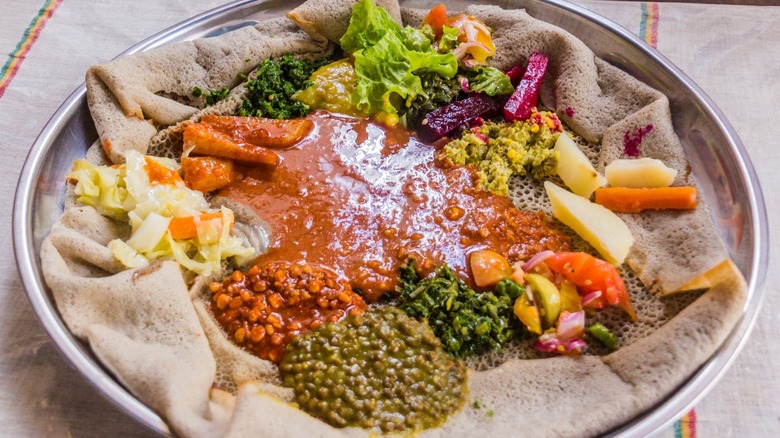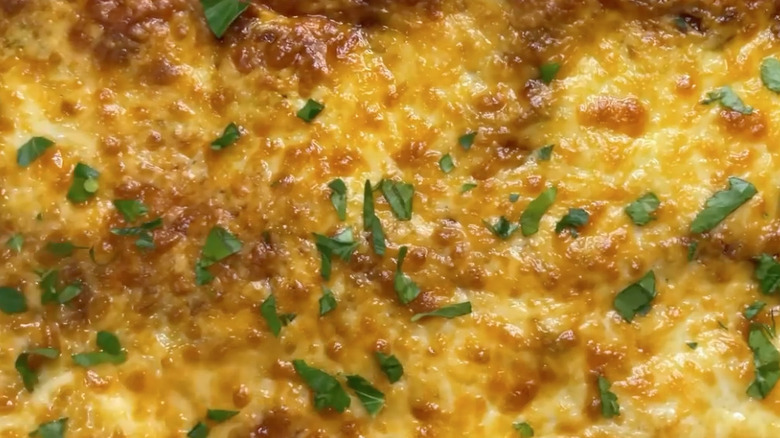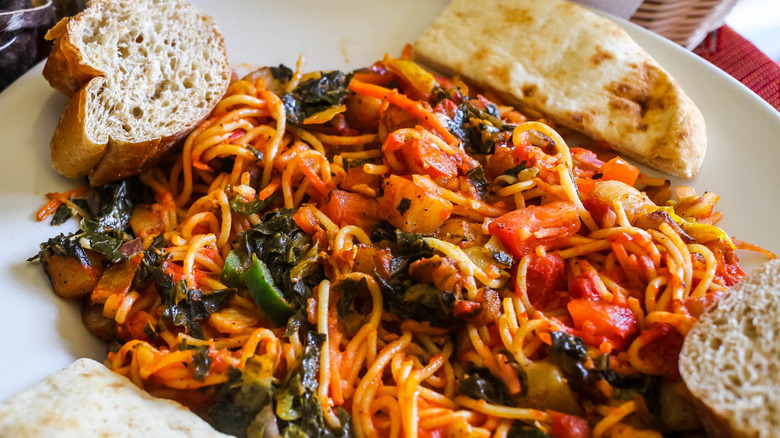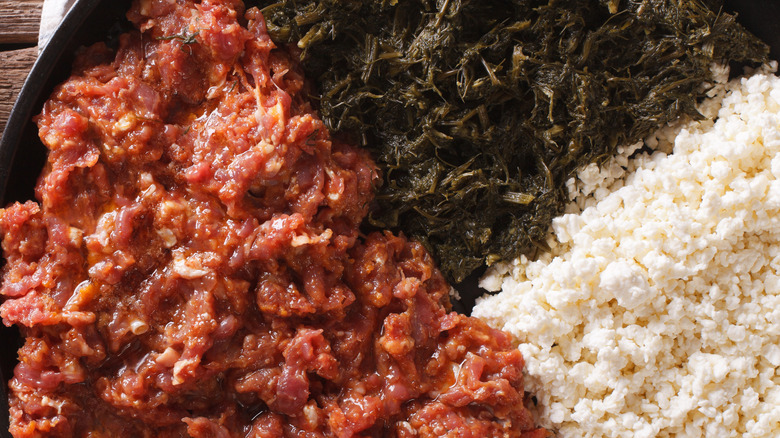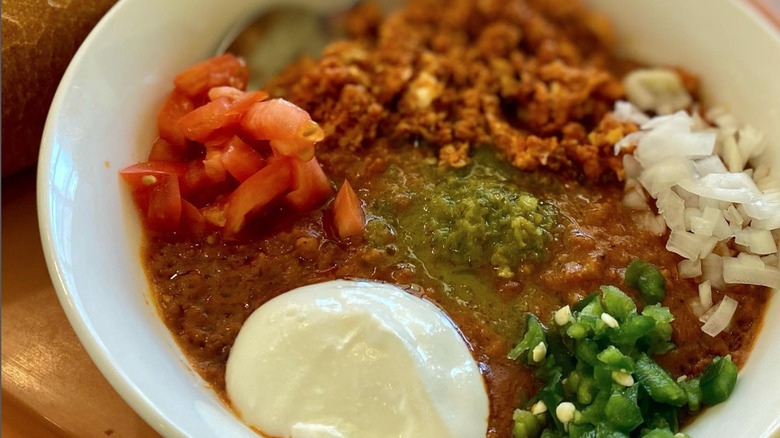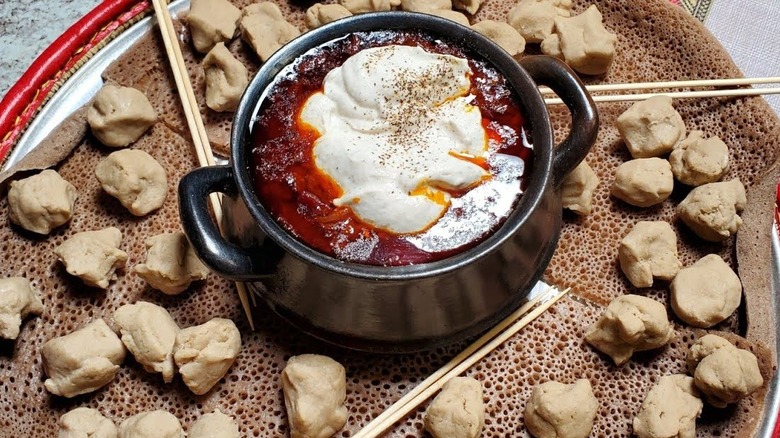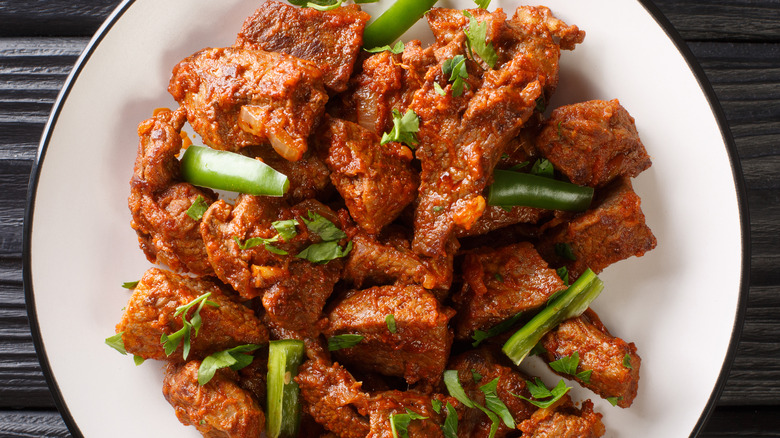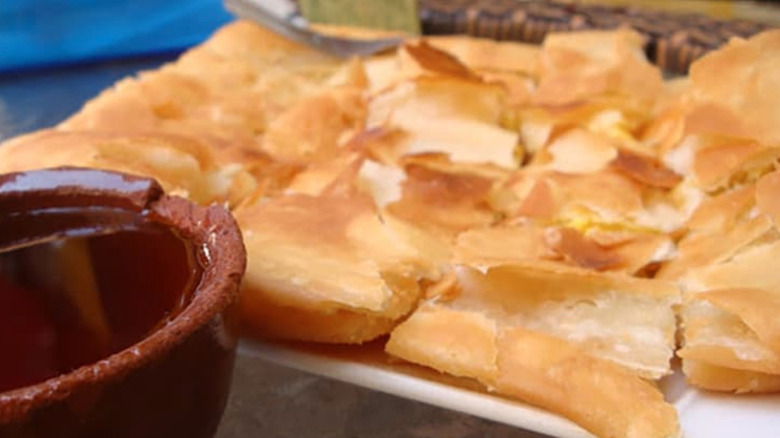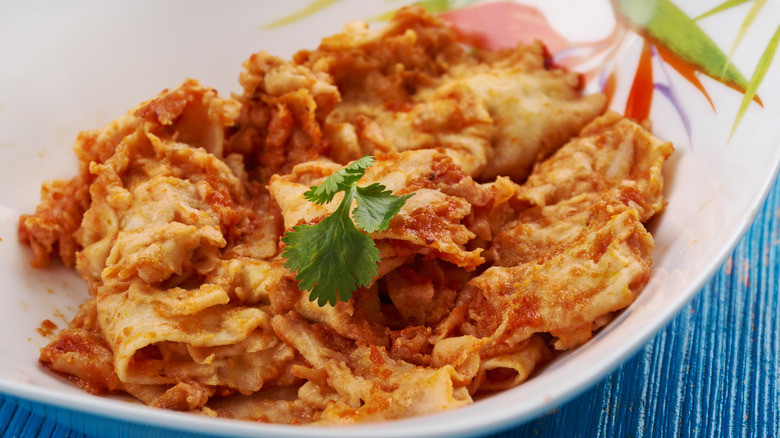Iconic Ethiopian Foods You Have To Try Before You Die
Ethiopian food may not be as ubiquitous in the United States as, say, Mexican or Chinese food, but it has found a home in many pockets of the country — especially Washington, DC. And according to The Food Institute, the cuisine is steadily becoming more popular in America as consumers become more willing to experience new flavors. So for those who haven't yet chowed down on authentic Ethiopian grub, consider this a crash course.
Ethiopian cuisine is all about hands-on, communal eating. Instead of using cutlery like forks and spoons as people do in the West, Ethiopians use a flat, crepe-like bread called injera to scoop their food (via Houston Press). This spongy, tangy bread made of nutrient-rich teff grass also often serves as a bed for other traditional foods, such as vegetables and spicy stews. In a word, injera is fundamental.
The other cornerstone of Ethiopian cuisine is a seasoning blend called berbere. Berbere is made with a laundry list of spices, including cumin, garlic, cloves, and chili peppers. Because of its complex use of spices, Ethiopian food is often compared to that of India. But the country also has its fair share of European influences, making for some dishes that first-timers may be surprised to find at Ethiopian eateries.
Without further ado, here are some of the country's most iconic dishes.
Doro Wat
Wat (or wot) are spicy stews that make up the bulk of Ethiopian cuisine. Wat is superficially similar to Indian curry, but it has an identity all its own. Doro wat, a chicken stew, is the country's national dish, and it's eaten for regular meals and for special occasions alike (via AZ Central).
Typically, you'll find online recipes calling for chicken thighs or drumsticks, but traditionally, the whole chicken is used. It is cut up into 12 pieces, which may represent the biblical 12 tribes of Jacob (via Chef Lola's Kitchen).
The other main elements are berbere, niter kibbeh (clarified spiced butter), onions, tomato paste, and hard-boiled eggs (which are tossed in at the end). The mixture is slow-cooked in a pot for hours to draw out the flavor of all of the ingredients. The result is a savory, crimson-colored stew that can pack some heat. As with all types of wat, doro wat is served on and eaten with injera.
Atkilt Wat
Because a sizable sector of the country's population is Orthodox Christian, many Ethiopians abstain from meat on Wednesdays and Fridays (via Best of Vegan). As a result, there are several vegetarian-friendly dishes in their culinary canon. One such dish is atkilt wat (or atakilt wot).
Atkilt wat is a vegetable stew consisting of cabbage, carrots, potatoes, onions, and sometimes peppers. Another similar Ethiopian cabbage dish is tikil or tikel gomen. According to Reddit user @jiggle_jiggle_jiggle, the latter is traditionally just cabbage. The word "gomen" itself could mean any kind of leafy green, such as collard greens. However, at Ethiopian restaurants in the U.S., like Almaz in Philadelphia, tikel gomen is a full mixed vegetable stew, and not just cabbage.
According to Riotact, atkilt wat tends to be a fairly mild stew without the berbere heat of other kinds of wat. It is often served on injera with other stews and vegetables, like a platter.
Shiro Wat
Another type of wat (we told you there were a lot) is shiro. Shiro (alternatively, shero or shuro) is a spicy stew made of ground chickpeas. It also traditionally contains onions, tomatoes, and an Ethiopian herb called besobela, thoughs recipes vary between cooks. Like other Ethiopia dishes, shiro is usually served on injera. Many restaurants also tend to partner it with a small side salad, collard greens, or vegetables.
In Ethiopia, The Washington Post reports, shiro is beloved for its flavor as well as its budget-friendly price. It's also the go-to meal for Orthodox Christians on holidays like Lent, when eating meat isn't permitted. But there's no need to worry about protein deficiency, as this legume-based stew is full of it, writes Dr. Asqual Getaneh, Associate Clinical Professor of Medicine at Columbia University. It also contains necessary vitamins like A and C, iron, and other healthy nutrients.
Beyainatu
Often, instead of just seeing one type of wat on injera, there will be multiple, as well as dollops of various kinds of cooked vegetables. The vegetarian version of this platter is beyainatu, the approximate translation for which is "a bit of every type" (via mamakoo). It is a beautiful, colorful dish, like the foodie's version of a painter's palette, featuring everything from stewed lentils to tomato salad (via The Toronto Star).
The meat eater's version is called mahaberawi. While mahaberawi also usually involves vegetables, the stars of this carnivore's feast are meat dishes. The specific choices vary, but beef stew (key wat), lamb stew (yebeg wat), and stir-fried pieces of meat (tibs) are popular choices. Since there are so many different types of dishes present on these combination platters, it's best to enjoy beyainatu and mahaberawi with friends or family. That's the Ethiopian way, after all!
Ethiopian lasagna
Under the dictatorship of Benito Mussolini, Italians took control of East Africa in 1935, and remained there until they were ousted in 1941 (via Imperial War Museums). This occupation left tremendous scars on Ethiopia, as well as modern-day Eritrea, which only gained independence from Ethiopia in 1993. But it also left a mark on the local cuisine, shaping what is now a very complicated yet tasty relationship with the locals' colonial past.
Today in both Ethiopia and Eritrea, Italian staples like lasagna and other types of pasta dishes are easy to find. According to Saveur, East Africans even enjoy the Italian sweet bread panettone during Christmastime. But of course, Italian food in this region has developed its own flair — most notably in the spice department.
Hannah Giorgis of Taste writes that no two Ethiopian lasagna recipes are the same, but generally, they all include the country's signature berbere spice. According to her, Ethiopian lasagna also tends to be more beef-heavy, and Italian ricotta is often replaced with other, more easily accessible cheeses such as cheddar.
Ethiopian Spaghetti
There are various types of Ethiopian spaghetti dishes. In Eritrea, pasta is ubiquitous, including more niche pasta shapes like tagliarini and orecchiette. One resident told The New York Times that he eats pasta every day at least once. Some incorporate vegetables, others fish or meat, but the base for most of them is usually a spicy tomato sauce. Think you can guess what brings the heat? That's right, it's berbere. And at Desta Ethiopian Kitchen in Georgia, they even serve pasta with lamb, chicken, or kitfo, a type of Ethiopian beef.
Westerners usually eat spaghetti with a fork, but in Ethiopia, pasta is also often eaten with injera (via Gastro Obscura). It may seem messy, but instead of a full plate of spaghetti, a small portion is placed on the soft Ethiopian flatbread much in the same way wat is served. This is definitely a dish for fusion buffs.
Kitfo
While Ethiopia may be home to some delicious vegetarian dishes, the people there certainly do love their meat. In fact, they even eat it raw. The most striking raw meat dish is tere siga, which literally translates to "raw meat," and consists of hunks of fresh animal flesh carved at the table (via the LA Times). But another popular raw meat dish, kitfo, comes ground and seasoned, which is probably more palatable for Westerners who are familiar with steak tartare. There is also gored gored, which is diced raw beef seasoned with hot peppers.
If you're wary of eating meat completely raw, most Ethiopian restaurants will accommodate if you ask for your kitfo to be slightly cooked (lebleb) or even fully cooked (yebesele); however, you may miss out on that melt-in-your-mouth texture. The only other ingredients for this traditional dish are niter kibbeh and spices. Kitfo is often accompanied by cooked greens and Ethiopian cottage cheese (ayib) and served on injera.
Ful
Those who have heard of ful likely know it as ful mudammas (or ful medames), an Egyptian breakfast stew made with fava beans. But the legume-based dish can also be found in Ethiopia, made with its own unique ingredients. According to Westword, the Egyptian version is typically made with lemon juice, tahini, and chopped parsley. Ethiopian ful is spicier, however, thanks to the ever-present berbere spice blend. A host of toppings can also be added to ful, such as diced tomatoes, peppers, onions, boiled eggs, or a dollop of yogurt. Crusty bread is usually served on the side for dipping.
Fava beans are a great source of fiber and protein, making ful a healthy way to start the day. Fava beans also contain vitamins and minerals such as manganese, phosphorus, and folate (via Healthline). Combine that with the other nutrients in the toppings listed above, and it's basically a breakfast power bowl.
Tihelo
The Tigray is a region of Northern Ethiopia that has been embroiled in a civil war with the Ethiopian state since 2020 (via The New York Times). According to the Journal of Ethnic Foods, one of the most popular dishes to come out of Tigray is tihelo, which is a doughy starch food dipped into sauce.
The process for creating this seemingly-simple barley dough is quite complex. To make it, barley grains are pounded, winnowed, soaked in water, dried, toasted, pounded and winnowed again, then ground and sifted. The sifted barley flour is then mixed with cold water to make dough. The freshly kneaded barley dough is separated and pinched into small, ball-like pieces, which are dipped into a hot tomato-based sauce using a long, spear-like utensil called a shenter. The sauce can also be made with meat, butter, or various types of beans. Like Western fondue, this is an excellent group meal.
Tibs
The concept of tibs is simple: cubes of meat cooked in a pan with spices, tomatoes, red onions, and often hot peppers. Most of the time, tibs are either beef or lamb, but there are also fish tibs and even mushroom or eggplant tibs for a vegetarian twist on the formula. Ethiopian restaurants like Habesha in Austin, Texas, carry an assortment of tibs options. While the idea is simple, the flavors are big, and the amount of variety in preparation means no two versions of tibs will taste exactly the same.
As with most Ethiopian entrees, you may see tibs served alongside awaze sauce (via Taste Atlas). It is a blend of berbere, oil, and tej (or t'ej), which is a traditional Ethiopian honey wine. Bottled awaze, like Saba's Original, is also available at specialty grocery stores. Saba's version includes additional ingredients like water, vinegar, lemon juice, and more spices.
Fatira
Fatira is a savory-sweet Ethiopian breakfast food that kind of resembles a breakfast quesadilla, sans the cheese. According to Face 2 Face Africa, it's also a common street food. It consists of scrambled eggs (sometimes mixed with chopped peppers, onions, and tomatoes) and honey in between two pieces of flatbread or flaky, pastry-like dough. The honey may also be served on the side for dipping.
Fatira is usually cut up into squares and served with coffee — which, by the way, is another iconic Ethiopian item you must taste. According to Home Grounds, arabica coffee actually originates from Kaffa province in southwest Ethiopia, hence the name "coffee." Pure Ethiopian coffee possesses a flavor profile that is fruity and medium-bodied. Freshly ground coffee in Ethiopia would obviously provide the best tasting experience, but if you're making fatira at home, make sure you have a bag of some kind of ingle-origin arabica coffee ready to brew.
Chechebsa
Another popular breakfast food called chechebsa combines the basic pillars of Ethiopian cuisine into one extremely simple dish. It's also a good way to stretch your dollar and still get something delicious out of it, especially if you live in an Ethiopian household where the ingredients are guaranteed to always be around. If you're not one for cooking, this dish can be found at Ethiopian restaurants, like Geni's Ethiopian Corner in Seattle.
So, how is it made? First, either injera or a different type of flatbread called kita is torn bite-sized pieces and coated in niter kibbeh with berbere. After that, the spiced bread pieces get tossed into a pan and fried (via World Food Guide). And that's really it. The three most necessary things to Ethiopian cooking — bread, butter, and berbere — in one easy, spice-heavy breakfast. Oftentimes, as at Geni's, the chechebsa is served with honey to give the dish a sweet-spicy kick.
